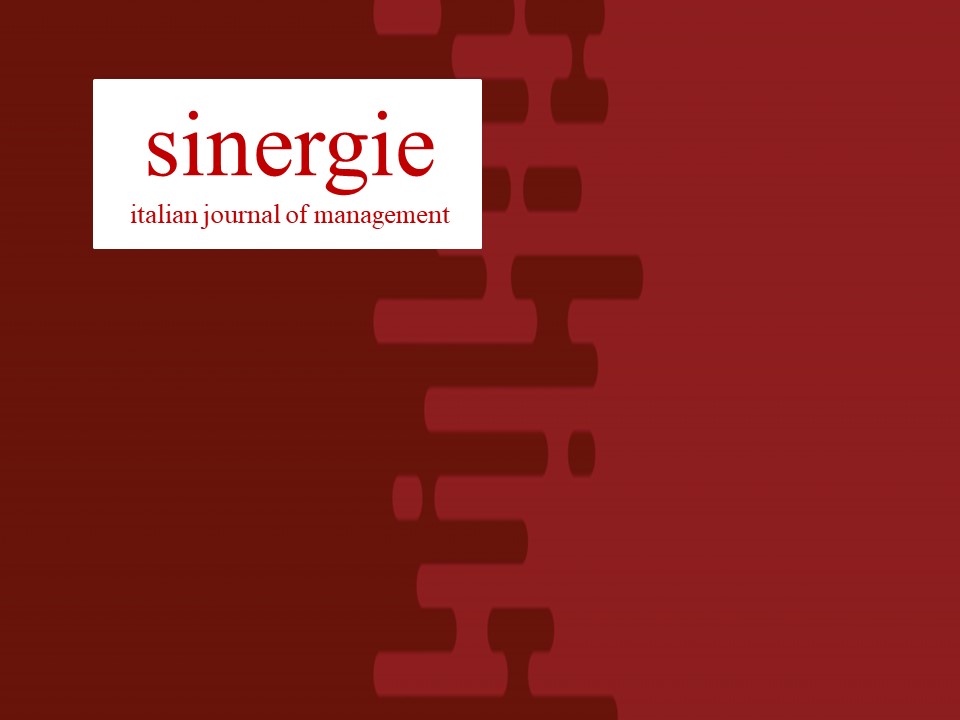Agilità nella logistica delle emergenze. Le imprese apprendono dalle organizzazioni umanitarie
Obiettivo del paper: Il presente contributo indaga quali opportunithanno le imprese di imparare lagilitdella supply chain dal settore umanitario nella gestione delle emergenze, al fine di incrementare la propria competitività.
Metodologia: Per indagare la domanda di ricerca si sono svolte una review della letteratura e unindagine empirica di natura esplorativa, con metodologia qualitativa basata sullo studio di casi. In particolare, nella parte empirica si approfondita liniziativa dei Logistics Emergency Teams, il primo e unico caso a livello internazionale di partnership tra un gruppo dimprese logistiche e il settore umanitario nellorganizzazione logistica delle operazioni di risposta alle emergenze.
Risultati: La letteratura e la realtoperativa analizzate mettono in evidenza che le imprese possono realmente cogliere lopportunitdi apprendere lagilitdalle best practice umanitarie. Ciavviene cooperando nelle operazioni di risposta a un disastro, nella fase di primo soccorso, e condividendo concretamente – a livello operativo e strategico – obiettivi, principi e linee-guida dellagilitimplementati nella supply chain umanitaria.
Limiti della ricerca: Questo studio esplorativo, pur avendo fornito spunti inediti sul tema, necessita di essere ampliato nella parte empirica, con ulteriori interviste agli esponenti delle imprese logistiche coinvolte.
Implicazioni pratiche: Lesperienza che le imprese fanno durante la collaborazione col settore umanitario non solo contribuisce alla migliore riuscita dellintervento di soccorso, ma potenzia la capacitcompetitiva delle singole imprese, se queste riescono a far proprie e trasferire le competenze apprese nella gestione ordinaria della propria supply chain commerciale.
Originalità del paper: La prospettiva indagata nella presente ricerca assai originale negli studi accademici e professionali; solo recentemente, infatti, si sta ponendo attenzione su cosa le imprese possano apprendere dal settore umanitario, mentre nel passato lenfasi era posta specialmente sul processo inverso di apprendimento.
Riferimenti bibliografici
AITKEN J., CHRISTOPHER M., TOWILL D. (2002), Understanding, implementing and exploiting agility and leanness, International Journal of Logistics: Research & Applications, vol. 5 n. 1, pp. 59-74.
AUSTIN J.E. (2000a), Strategic collaboration between nonprofit and businesses, Nonprofit and Voluntary Sector Quarterly, vol. 29 n. 1, pp. 69-97.
AUSTIN J.E. (2000b), The collaboration challenge, Jossey-Bass, San Francisco.
BINDER A., WITTE J.M. (2007), Business Engagement in Humanitarian Relief: Key trends and policy implications, Global Public Policy Institute (GPPi).
BLANSJAAR M., VAN DER MERWE C. (2011), The importance of information technology in humanitarian supply chains: opportunities and challenges in the Helios project, in Christopher M., Tatham P., Humanitarian logistics. Meeting the challenge of preparing for and responding to disasters, Kogan Page, London, pp. 47-63.
BOWERSOX D.J., CLOSS D.J. (1996), Logistical Management: The Integrated Supply chain Process, McGraw-Hill, New York.
CHARLES A., LAURAS M., VAN WASSENHOVE L.N. (2010), A model to define and assess the agility of supply chains: building on humanitarian experience, International Journal of Physical Distribution & Logistics Management, vol. 40 n. 8/9, pp. 722-741.
CHILDERHOUSE P., TOWILL D. (2000), Engineering supply chains to match customer requirements, Logistics Information Management, vol. 13 n. 6, pp. 337-345.
CHRISTOPHER M. (2005), Logistics and Supply chain Management. Creating Value Adding Networks, Prentice Hall, London.
CHRISTOPHER M. (2000), The Agile Supply Chain: Competing in Volatile Markets, Industrial Marketing Management, vol. 29, n. 1, pp. 37-44.
CHRISTOPHER M. (1992), Logistics & Supply chain Management, Pitmans Publishing, London.
CHRISTOPHER M., TOWILL D.R (2000), Supply chain Migration from Lean and Functional to Agile and Customised, Supply chain Management: An International Journal, vol. 5, n. 4, pp. 206-213.
CHRISTOPHER M., TATHAM P. (2011), Introduction, in Christopher M. e Tatham P. (Eds.), Humanitarian logistics. Meeting the challenge of preparing for and responding to disasters, Kogan Page, London, pp. 1-14.
CONFORTI A., COZZOLINO A., ROSSI S. (2008), Il supply chain management delle emergenze umanitarie. Il caso del World Food Programme, Finanza Marketing e Produzione, vol. 2, n. 2, pp. 25-48.
COZZOLINO A. (2013), Lagilit nella logistica delle emergenze. Come le imprese apprendono la gestione dellimprevedibile dalle organizzazioni umanitarie nelle operazioni di primo soccorso, Convegno Aidea, Lecce, Il ruolo dellazienda nelleconomia. Esiste un modello aziendale orientato alla crescita?, 19-21 settembre 2013.
COZZOLINO A. (2012), Humanitarian logistics. Cross-Sector Cooperation in Disaster Relief Management, SpringerBriefs in Business Series, Springer.
COZZOLINO A. (2009), Operatori logistici. Contesto evolutivo, assetti competitivi e criticit emergenti nella supply chain, Cedam, Padova.
COZZOLINO A., ROSSI S., CONFORTI A. (2012), Agile and Lean Principles in the Humanitarian Supply Chain. The Case of the United Nations World Food Programme, Journal of Humanitarian Logistics and Supply chain Management, vol. 2, n. 1, pp. 16-33.
GATTORNA J. (2006), Living Supply Chains: How to Mobilize the Enterprise Around DeliveringWhat Your Customers Want, Financial Times Prentice Hall, London.
HARRISON A., CHRISTOPHER M., VAN HOEK R. (1999), Creating the Agile Supply Chain, Chartered Institute of Logistics and Transport.
HARTLEY J. (2004), Case study research in Cassell C.M., Symon G. (eds), Essential guide to qualitative methods in organizational research, Sage, London, pp. 323-333.
HOFMAN D., CECERE L. (2005), The agile supply chain, Supply chain Management Review, vol. 9 n. 8, pp. 18-9.
KANTER R.M. (1999), From spare change to real change. The social sector as beta site for business innovation, Harvard Business Review, vol. 77, n. 3, pp. 122-132.
KOVCS G. (2011), So where next? Developments in humanitarian logistics, in Christopher M., Tatham P., Humanitarian logistics. Meeting the challenge of preparing for and responding to disasters, Kogan Page, London, pp. 249-263.
KOVCS G., SPENS K.M. (2009), Identifying challenges in humanitarian logistics, International Journal of Physical Distribution and Logistics Management, vol. 39, n. 6, pp. 506-528.
LAPIDE L. (2006), The essence of excellence, Supply chain Management Review, vol. 10 n. 3, pp. 18-25.
LEE H.L. (2004), The Triple-A Supply Chain, Harvard Business Review, October, pp. 102-112.
MAON F., LINDGREEN A., VANHAMME J. (2009),Developing supply chains in disaster relief operations through cross-sector socially oriented collaborations: a theoretical model, Supply chain Management: An International Journal, vol. 14 n. 2, pp. 149-164.
MASON-JONES R., NAYLOR B., TOWILL D.R. (2000), Lean, agile or leagile? Matching your supply chain to the marketplace, International Journal of Production Research, vol. 38, n. 17, pp. 4061-4070.
MASSARONI E. (2007), Il sistema logistico. Progettazione, governo e gestione della logistica e della supply chain, Cedam, Padova.
MASSARONI E., COZZOLINO A. (2012), Modelli della produzione industriale, Cedam, Padova.
MCCRACKEN G. (1998), The long interview, Beverly Hills, Sage, CA.
NARASIMHAN R., SWINK M., KIM S.W. (2006), Disentangling leanness and agility: an empirical investigation, Journal of Operations Management, vol. 24, n. 5, pp. 440-457.
NAYLOR J.B., NAIM M.M., BERRY D. (1999), Leagility: Interfacing the Lean and Agile Manufacturing Paradigm in the Total Supply Chain, International Journal of Production Economics, vol. 62, n. 1-2, pp. 107-118.
NONAKA I. (1994), A dynamic theory of organizational knowledge creation, Organization Science, vol. 5, n. 1, pp. 14-37.
OGLESBY R., BURKE J. (2012), Platforms for private sector-humanitarian collaboration, King’s College London, London.
OLORUNTOBA R., GRAY R. (2006), Humanitarian aid: an agile supply chain?, Supply Chain Management: an International Journal, vol. 11, n. 2, pp. 115-120.
PECK H. (2005), Finding better way to deal with disasters, Logistics and Transport Focus, vol. 7, n. 10, pp. 19-21.
PETTIT S.J., BERESFORD A.K.C. (2009), Critical success factors in the context of humanitarian aid supply chains, International Journal of Physical Distribution and Logistics Management, vol. 39, n. 6, pp. 450-468.
PORTER M.E., KRAMER M.R. (2002), The Competitive Advantage of Corporate Philanthropy, Harvard Business Review, vol. 80, n. 12, pp. 56-68.
QUINN E. (2010), Logistics for food assistance: delivering innovations in complex environments, in Omamo S.W., Gentilini U., Sandstrm S. (Eds.), Revolution: from food aid to food assistance. Innovations in overcoming hunger, World Food Programme, pp. 307-328 (http://documents.wfp.org/stellent/groups/public/documents/newsroom/wfp225973.pdf).
SAMII R., VAN WASSENHOVE L.N. (2004), Moving the World: TNT-WFP partnership -learning to dance, INSEAD, Case study n. 2004-5194.
SAMII R. (2008), Leveraging logistics partnerships. Lessons from humanitarian organizations, Doctorate Thesis, Erasmus University Rotterdam, December.
SCHOLTEN K., SCOTT P.S., FYNES B. (2010), (Le) agility in humanitarian aid (NGO) supply chains, International Journal of Physical Distribution & Logistics Management, vol. 40, n. 8/9, pp. 623-635.
SHEFFI Y. (2005), The Resilient Enterprise: Overcoming Vulnerability for Competitive Advantage, MIT Press, Cambridge, MA.
SPRING S. (2006), Relief when you need it. Can FedEx, DHL and TNT bring the delivery of emergency aid into the 21st century?, Newsweek – International Edition, 11 Sept. 2006 (http://www.fritzinstitute.org/PDFs/InTheNews/2006/newsweek-I-091106.pdf).
STADTLER L., VAN WASSENHOVE L.N. (2012), The Logistics Emergency Teams – Pioneering a new partnership model, Case Study, INSEAD, European Case Clearing House, ECCH (Ref. No. 712-033-1), pp. 1-20.
STAPLETON O., STADTLER L., VAN WASSENHOVE L.N. (2012), Private-humanitarian supply chain partnership s on the silk road, in Haksz C., Seshadri S., Iyer A.V., Managing supply chains on the silk road. Strategy, performance, and risk, CRC Press, pp. 217-238.
STRAUSS S. (1987), Qualitative Analysis for Social Scientists, Cambridge University Press, New York.
TAYLOR D., PETTIT S. (2009), A consideration of the relevance of lean supply chain concepts for humanitarian aid provision, International Journal of Services Technology and Management, vol. 12 n. 4, pp. 430-444.
THOMAS A., FRITZ L. (2006), Disaster relief, Inc., Harvard Business Review, vol. 84, n. 11, pp. 114-26.
TOMASINI R.M., VAN WASSENHOVE L.N. (2009b), Humanitarian Logistics Macmillan, Palgrave.
TOMASINI R.M., VAN WASSENHOVE L.N. (2009a), From preparedness to partnership s: case study research on humanitarian logistics, International Transactions in Operational Research, vol. 16, n. 5, pp. 549-559.
TOWILL D., CHRISTOPHER M., (2002) The supply chain strategy conundrum: to be lean or agile or to be lean and agile?, International Journal of Logistics: Research and Applications, vol. 5, n. 3, pp. 299-309.
VAN HOEK R.I., HARRISON A., CHRISTOPHER M. (2001), Measuring agile capabilities in the supply chain, International Journal of Operations & Production Management, vol. 21 n. 1/2, pp. 126-148.
VAN WASSENHOVE L.N. (2006), Blackett Memorial Lecture. Humanitarian aid logistics: supply chain management in high gear, Journal of the Operational Research Society, vol. 57, n. 5, pp. 475-489.
VAN WASSENHOVE L.N., STAPLETON O., TOMASINI R.M. (2008), Corporate Responses to Humanitarian Disasters: The Mutual Benefits of Private-Humanitarian Cooperation, The Conference Board, Research Report (R-1415-08-WG).
WYMER W.W., SAMU S. (2003), Dimensions of business and non-profit collaborative relationships, in (Edited by) Wymer W.W., Samu S., Nonprofit and business sector collaboration. Social enterprises, cause-related marketing, sponsorships, and other corporate-nonprofit dealings, Best Business Books, The Haworth Press, Binghamton, pp. 3-22.
YANG B., BURNS N.D., BACKHOUSE C.J. (2004), Management of uncertainties through postponement, International Journal of Production Research, vol. 42, n. 6, pp. 1049-1064.
YIN R.K. (1994), Case Study Research: Design and Methods, 2nd edition, Sage Publications, Thousand Oaks, IL.


